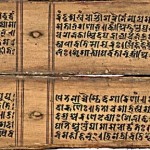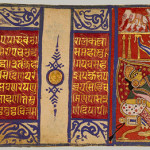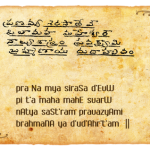Rebuilding the National Character involves not only understanding what we need to do, or even why we are doing it, but why it is worth preserving at all.
Civilization is more than the mere sum of its principles, precepts, philosophies, and pasts. It extends beyond even an ideal or reciprocal duties. At its uttermost height, it is in fact, a sentiment. Bharatiya Sanskriti is very much about Dharma, Rta, and Satya, but that Satya that is at its heart, is also the timeless Truth of Prema.
For Indic Civilization, for any Civilization, to Revive itself, it must not only think, dream, and converse in its own language, it must also love and romance in it. Sringara (Romance) is also Part of Our Culture. For far too long have its masses been misguided by foreign thoughts ennobled by Indian implementations, or foreign thinkers using local rustics to change the meaning of our words. And for far too long have they reduced the Indian, the Indic, the Hindu Culture we know & love as only ascetic or erotic., when it is also Romantic. The very height of the Romantic in Classical India was the Sanskritic.
And which wordsmith could be more romantic than than that master of Simile, Mahakavi Kalidasa,and his eternal Kavya. For almost 2,000 years, this most perfect of poets has made even the most pedantic recognise that simplicity is the ultimate sophistication. Long before Shakespeare asked “Shall I compare thee to a summer’s day“, the Court Poet of King Vikramaditya had become the utmost paragon of Upama, with comparisons that were as fresh and unique as the flowers that garlanded the Gods.
Ours was, and is, a civilization and culture of not only great warriors and devout women, but also charming gentlemen and passionate princesses. But as all things in Dharma, it is time, place, and manner that takes a natural feeling and ennobles it to a timeless aesthetic. And what can be more aesthetic than the romantic?
Therefore, without further ado, we bring you the first in an Anthology (accompanied by commissioned artwork), a concept that was a decade in the making…
…and the next installment of our Continuing Series on Classical Indic Literature:
Romantic Sanskrit Poetry.
Composition
Ancient India had many timeless love stories. Katha, Kavya, Purana, and Itihasa are replete with lovelorn lovers, hopeless romantics hoping against hope, and eternal soulmates reuniting with each other across times and lifetimes. True, Rukmini & Sri Krishna, Sita & Rama, and Siva-Parvati, are all famous Divine lovers. But even we mortals figured in our ancient tales, in love stories worthy of not only drama, and opera, but even cinema.
Quite possibly the most famous of such prema kathas comes from the Land of the Kurus. The sons of Bharata take their name from that Bharata born to this couple, who entwined the legendary with the historical. The ancestors of the great Emperors of Hastinapura were the great Chandravanshi King and Conqueror, Maharaja Dusyanta & his lady love Sakuntala.
Mentioned in the Mahabharata, this courting couple was forever immortalised by Mahakavi Kalidasa. His famed drama was called Abhijnana-Sakuntalam: The Recognition of Sakuntala. This paramount of romantic poets produced a timeless tale of love, separation, and reunification. The composition was artful, the verses were tasteful, and the numerous productions of this play wonderful, across the centuries. Such were the Kailasan heights that Sanskrit Drama ascended to, that many thousands of years later, the famed German poet-philosopher Goethe exclaimed:
Willst du die Blüthe des frühen, die Früchte des späteren Jahres,
Willst du, was reizt und entzückt, willst du was sättigt und nährt,
Willst du den Himmel, die Erde, mit Einem Namen begreifen;
Nenn’ ich, Sakuntala, Dich, und so ist Alles gesagt.
Wouldst thou the young year’s blossoms and the fruits of its decline
And all by which the soul is charmed, enraptured, feasted, fed,
Wouldst thou the earth and heaven itself in one sole name combine?
I name thee, O Sakuntala! and all at once is said. [4]
So fascinated were foreigners by the Recognition of Sakuntala that there are 46 translations of this play in 12 European languages, going back to the first in 1789. Indeed, in Europe, even a libretto was composed and Operas performed on it, at the height of the Colonial era. While it is nice to impress the videshi, however, it is better to take inspiration from the Bharatvasi. Sakuntala was forever ceremonialised by Raja Ravi Varma in his celebrated paintings. She is seen here with friends, artfully posing.

Sakuntala has also been produced not only on stage (including a notable English language production in 1920) but on-screen many times starting with a silent film (also in 1920). Yet so-called contemporary “national cinema” seems to have forgotten it (except back in 1947) for the time-worn recipes and veneers-of-lust masquerading as romance produced with parasika playwrights. Production values and marketing and black money may make it big at the box office, but it is the beating heart of a civilization and the sentiments and emotional verses it perfected, that make truly time-tested art.
The time has come for a new production of the great plays of Mahakavi Kalidasa, the foremost of which was the Recognition of Sakuntala. If compromised producers don’t have the fortitude, than the public at large should crowdsource a production with a talented director armed with artistic talent. This great Sanskrit drama could elegantly flow with Shuddh Hindi (or in my case, Telugu) dialogue that sets the stage for elegant Sanskrit verses, across scenes. Serenading with song may be well and good; charming with poetry is even better.
As Bollywood may not have the national interest at heart, perhaps it’s time for Tollywood to again step into the vacuum and inspire the nation. To do so, let would-be directors study the composition first.
Abhijnaana-Saakuntalam
A play in 7 acts, it begins with the traditional Prastaavana (Prologue) and Benediction (Nandi). Despite being a drama, Abhijnaanasaakuntalam is a veritable treasure trove of poetry with 34 slokas in the first act, 18 in the second, 26, in the third, 21 in the fourth, 31 in the fifth, 32 in the sixth, and 35 in the seventh…a grand total of 197 couplets.
This opus is interwoven with supple Sanskrit slokas, a multitude of characters, and the prominent theme of Sringara Rasa (Romantic sentiment). “The drama ‘was meant for translating the whole subject from one world to another—to elevate love from the sphere of physical beauty to the eternal heaven of moral beauty’“. [1, xxiv]
The Nayaka (hero) is Dusyanta of the House of the Kurus and the Nayika is Sakuntala, daughter of Sage Viswamitra and the Apsara Menaka. She had been cared for by Saakuntas (birds) and was therefore called Sakuntala. She was later raised by Maharishi Kanva, and grew up into a beautiful woman. The recognition of Sakuntala has in fact come down to us in two versions. The traditional one is found in the Mahabharata. Kalidasa gives us another, however, that brings us a brilliant battle in the Heavens with Dusyanta assisting the Devas in their war against the Asuras.
There are total of 4 recensions (a Devanagari, a Bengali, a Kashmiri, & an Andhra one) and two variations of the story. Nevertheless, both of these versions retell the birth of Bharata Dausanti, better known as Sakuntala-putra Bharata. Though the original Bharata who gave his name to our Land was the son of Rishabha of the Ikshvaku Dynasty, for a period of time, it was called Nabhi-varsha (after a king of the same House). But Sakuntala-putra was so famed for his world conquest and righteous rule, that the name Bharatavarsha came into fashion once more.
Whichever version you prefer, there is surely a blockbuster movie in the making here. If only the right director, with the right vision, and the right talent (and the right finances!) comes along. But financial matters are for the bean-counters. The aesthete is more concerned with the achievement of the author, and the talent that created this work.
Author

The biography of that best of Kavis, Kalidasa, is a tale in and of itself—indeed, it is worth of a book, an article, a cinema, or several. Correspondingly, the writer who intertwined legend with history and delightful fancy with moral principles, led a life of similar meeting points. By the present foreign paradigm, he is dated to the 4th century CE, but it is more likely that he belongs to the 1st Century BCE instead.
The foregoing discussion is enough to justify the truth and the vitality of the age-long tradition that the poet belongs to the days of the glorious King Vikramaditya of Ujjayini—the founder of the Samvat era (57 B.C.) [1, vi]
It is not for nothing that Jayadeva (of Gita Govinda fame) referred to Kalidasa as “Kavi kula guru” (master of poets). Famous for his love of Ujjayini (in modern Madhya Pradesh) and praise of Vikrama, Kalidasa was and is the undisputed King of Kavya. Blessed by the Goddess from whom he takes his name, this ‘Servant of Kaali’ would go on to marry a princess and be considered one of the Navaratnas—Nine Gems of Avanti’s Court. “Ujjayini was the city of his heart and he is delighted to sing of her glories and the romantic loves of her maidens“. [1, vi] He would set standards of excellence in poetry for millennia.
- 7 works of his have come to us today.
- 3 dramas, 2 epics, 1 lyrical poem, and 1 descriptive poem. [1]
Abhijnaana-Saakuntalam is arguably the most immortalised of all of Kalidasa’s compositions. While his other dramas (Malavika-Agnimitram & Vikramorvasiya) have also been celebrated on canvas, it was the story of the Signet ring that has captured imagination throughout the centuries.
The weaving of beautiful poetry, in the form of slokas (Sanskrit couplets), into the rupaka (dramatic composition) gives the literary experience more resonance. With the exception of Meghaduta, Kalidasa’s other works of pure poetry don’t rise to the same love of pure romantic sentiment. Kumarasambhavam is one of his contributions to the Pancha-Mahakavyas (the other being the famous Raghuvamsa), but it is an epic work with a hint of the erotic. Sringara-tilakam is very much a freshman oeuvre, but one that nevertheless gives us periodic foreshadowing of future talent, even in his younger days. And Rtu-samhara is very much a celebration of the seasons in all their splendour. Though Sringara rasa predominates, it is more of a descriptive work.
But while it is important to prepare the palate before cultivated taste can be appreciated in the aesthetic arts, one should not linger too long. This exegesis on this play, this poet, and this poetry, was all for the purpose of better understanding Sringara-Sanskrita-Kavya: Romantic Sanskrit Poetry.
To better prepare for married life, it is important to not only learn how to become eligible, but also marriageable. The courtly aesthetic is important not only in kingly courts, but in the courtship of couples.
Bharatiya boys, you may want to take notes. And Bharatiya ladies…you’re welcome…
Selections
§
I.Sarvat aapsara sambhavaisha
Maanushishi katham va syaadrsya roopasya sambhava |
Na prabhaatha ralam, jyothi, roodhethi, vasudaata laath ||
Truly born from a heavenly apsara
For what woman could give birth to such a lovely form.
After all, the sparkling light of tremulous beams, does not rise from the surface of the earth. [‘but descends from the heavens’] A.1 sl.26
 §
§
II.Kaamam priyaa na sulabha manasthu tabdaava darshanaa-srvaasi |
Akrutaarthe api manasije rati mubhaya-praarthanaa kurute ||
True, my darling is not easily attainable; yet my heart assumes confidence from observing the manner in which she seems affected.
Even though our love has not hitherto prospered, our mutual longing, nevertheless, causes delight. A.2 sl.1
§
III. (smitam krutva) Evamaatmaa-bhipraya sambhaaviteshta-jana-chittavrutti praartha-
Yitaa vidambyate tadhyatha
(smiling) Thus is the lover beguiled, who judges of the state of his beloved’s feeling by his own desires. It is thus
Snigdham veekshitam anyato’pi nayane yatpreyantyaa tayaa
Yaatham yach cha nithambayor guruthayaa mandham vilaasad iva |
Ma gaa ithyu-paruddhayaa yad api saa saasooyamuktaa sakhee
Sarvam Thathkila matparaayam aho kaamee svataam pashyati ||
The tender look she cast, even while she directed her eyes elsewhere; her slow movement caused by the heaviness of her hips, as if for grace’s sake; the angry words she spoke to her friend who detained her saying ‘Do not go; ‘ all this was, no doubt, on my account! Ah! How does a lover discover his own (everywhere!).A.2 sl.2
§
IV. Chitre niveshye parikalpita sattva-yogaa
Roopa-uchchayena manasaa vidhinaa krutaa nu |
Stree-ratna srushtir-aparaa prathibhaathi saa me
Dhaatur-vibhutvam-anuchintya vapuscha tasyah ||
Was she conceived in a picture [painting] and then endowed with life?
Or was she moulded in the Creator’s mind from an assemblage of all lovely forms?
When I meditate on the power of Brahma, and my beloved’s lineaments, she appears to me a matchless creation of the most beautiful of women. A.2 sl.9
§
V. Anaaghraataṃ puṣpaṃ kisalayam aloonaṃ kara-ruhair
Anaaviddhaṃ ratnaṃ madhu navam anaasvaadita-rasam |
Akhaṇḍaṃ puṣyaanaaṃ phalam iva ca tad-roopam anaghaṃ
Na jaane bhoktaaraṃ kamiha samupa-sthaasyati vidhiḥ ||
She seems a flower whose fragrance is yet unsavoured,
A gem uncut by workman’s tool,
A branch no desecrating hands have wasted,
Fresh honey, untasted and cool.
No man on earth deserves her beauty,
Her blameless loveliness and worth,
Unless he has fulfilled man’s perfect duty—
And is there such a one on earth? A.2.sl.10
§
VI. Priye
Smruthi bhinnamoha tamaso dhishtayaa pramukhe sthithaasi me sumukhi |
Uparaa gaante sasinaha samupa gathaa Rohini yogam ||
Oh Beloved,
By the kindness of heaven, O lovely-faced one, thou standest again before me, the darkness whose delusion has been dispelled by recollection.
The star Rohini, at the end of an eclipse, rejoins her (darling) moon. A.7 sl.22
§
Buy this Book Today! Buy this Book Today Buy this Book Today!
References:
- Devadhar, C.R. Works of Kalidasa: Volume I. Delhi: MLBD. 2005
- Ryder, Arthur W. Kalidasa: Translations of Shakuntala, and Other Works.New York, E.P. Dutton & Co.1914
- Rajan, Chandra. The Complete Works of Kalidasa: Volume 1 (Poets). New Delhi: Sahitya Akademi. 2005
- Goonetilleke, William. The Orientalist. Mumbai: Education Society Press.1985.p.101
- “Shakuntala”.IMDB. http ://www.imdb.com/find?ref_=nv_sr_fn&q=shakuntala&s=all
Ankitham: Dedicated to a 'Song Offering', who spent many a long & lonely night waiting to be sung and serenaded. Acknowledgment: Gratitude to the amateur voice actor who brought these couplets to life & vibrant resonance—a Lothario in real life,no doubt. Acknowledgment: My thanks to the Artist Archana,whose talent I'm sure, will blossom like the flowers she painted here. Special Acknowledgment: My utmost appreciation for Nilambari. Her tireless work consulting on this effort and ever insightful counsel ensured this project finally materialised after years. Thank you. *Minor Proofing for some translations










Dear Nripathi,
This is an exquisite post. Its shimmering and tremulous heartbeats are palpable. Was transported into the forests and gurgling streams and was thrilled by the romance of the guileless Sakuntala and the yearning Dusyanta in the commissioned artwork.
The recording was delicious. Minor grouse, minor grouse…it shd have been set to music. 🙂
But really an exquisite post which should go a small way in redefining the concept of romance in contemporary Bharatiya society.
Look forward to many more editions of this series…
Warmest regards
Nilambari